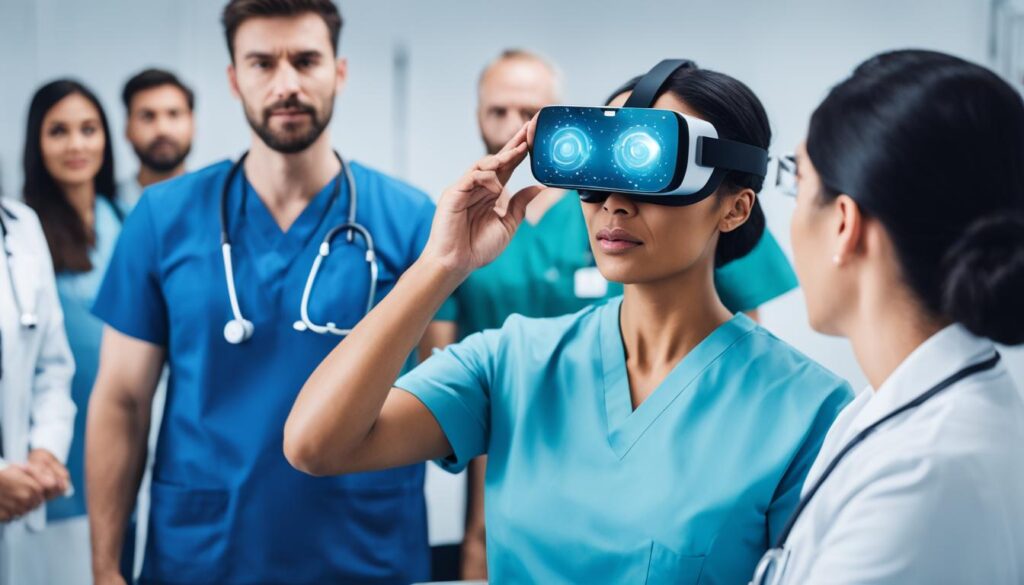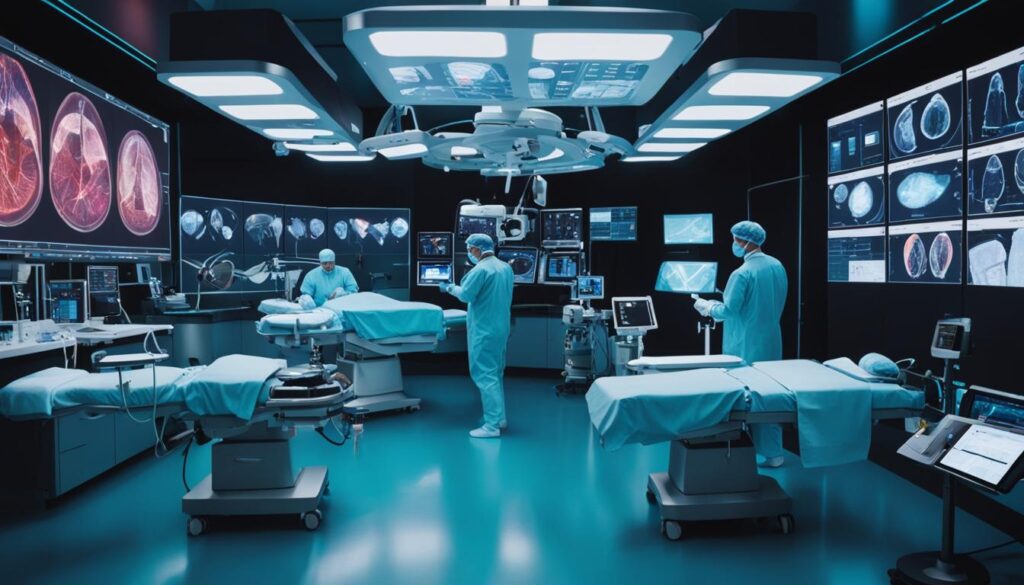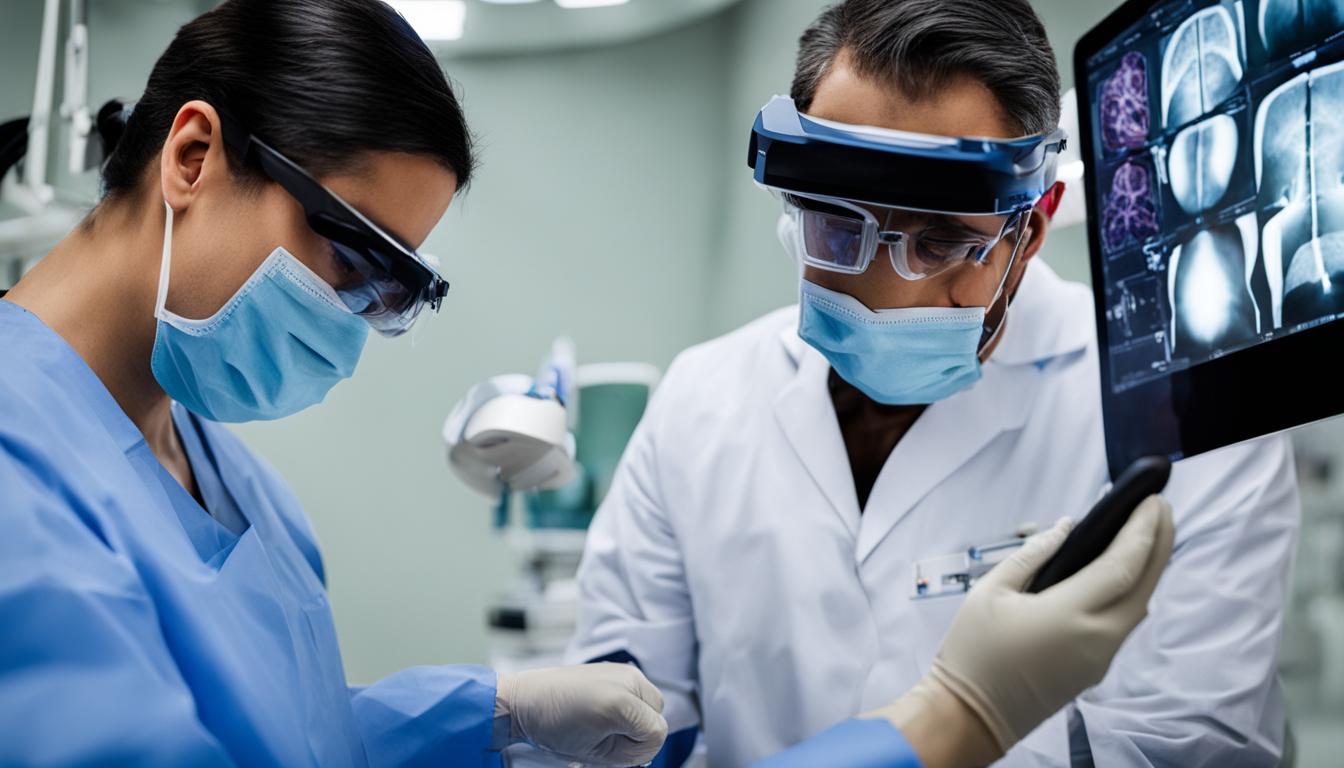The healthcare industry is constantly seeking innovative solutions to improve patient care and outcomes. One such solution gaining traction is augmented reality (AR). AR technology overlays digital content onto the real world, offering new ways to visualize and interact with medical data and patients. In the medical field, AR is transforming the way healthcare professionals diagnose, treat, and educate patients.
AR technology is being widely implemented in various healthcare settings, including telehealth, surgical and medical training, patient education, and rehabilitation. With the use of smart glasses and virtual headsets, medical professionals can access real-time information, visualizations, and simulations, enabling them to make more informed decisions and provide targeted treatments. Patients also benefit from AR through interactive visualizations of their anatomy or medical devices, helping them better understand their conditions and manage their health.
The use of AR in medicine presents numerous benefits, such as improved visualization and accuracy of patient anatomy, enhanced medical knowledge and skill, and increased patient engagement and satisfaction. It has the potential to revolutionize patient care and outcomes while advancing medical education and research.
Contents
- 1 Benefits of Augmented Reality in Healthcare
- 2 Applications of Augmented Reality in Medicine
- 3 Challenges of Implementing Augmented Reality in Healthcare
- 4 Future Developments of Augmented Reality in Healthcare
- 5 Conclusion
- 6 FAQ
- 6.1 How is augmented reality being used in the medical industry?
- 6.2 What are the benefits of augmented reality in healthcare?
- 6.3 What are the applications of augmented reality in medicine?
- 6.4 What are the challenges of implementing augmented reality in healthcare?
- 6.5 What are the future developments of augmented reality in healthcare?
- 6.6 What is the conclusion about augmented reality in healthcare?
- 7 Source Links
Key Takeaways:
- Augmented reality (AR) technology overlays digital content onto the real world in healthcare settings.
- AR is widely used in telehealth, surgical and medical training, patient education, and rehabilitation.
- AR improves visualization and accuracy of patient anatomy, enhances medical knowledge and skill, and increases patient engagement and satisfaction.
- AR has the potential to revolutionize patient care and outcomes, as well as advance medical education and research.
- AR provides interactive visualizations for patients, helping them understand their conditions and manage their health.
Benefits of Augmented Reality in Healthcare
Augmented Reality (AR) technology has emerged as a game-changer in the healthcare industry, offering a wide range of benefits for medical professionals, patients, and healthcare training programs. By leveraging the power of AR, medical practitioners can enhance their visualization and accuracy of patient anatomy, enabling them to plan and deliver personalized care more effectively.
One of the key medical applications of augmented reality is its ability to simulate patient anatomy and medical devices. With AR, patients can have a better understanding of their medical conditions and treatment options through interactive visualizations. This empowers them to actively participate in their own healthcare journey and make more informed decisions.
Moreover, augmented reality technology plays a vital role in healthcare training by offering immersive and interactive simulations. Medical students and healthcare professionals can practice complex procedures in a controlled virtual environment, honing their skills and gaining crucial experience. This hands-on training using AR not only improves their knowledge but also enhances patient safety by reducing the occurrence of errors during real-life procedures.
Another significant benefit of augmented reality in healthcare is its application in rehabilitation. By providing patients with visual feedback and motivation during physical therapy sessions, AR technology aids in enhancing their recovery process. It enables therapists to monitor and adjust therapy programs in real-time, ensuring optimal progress and better patient outcomes.
Additionally, augmented reality technology offers the following advantages:
- Improved accuracy and precision in surgical procedures
- Enhanced patient education and communication
- Streamlined workflow and time savings
- Increased operational efficiency in healthcare settings
- Facilitation of remote collaboration and telemedicine
AR has the potential to revolutionize the healthcare industry by transforming patient care and medical education. Its diverse applications and benefits make it a valuable tool for medical professionals seeking to deliver superior healthcare services and achieve better patient outcomes in an increasingly complex healthcare landscape.
Example Table: Medical Applications of Augmented Reality
| Application | Description |
|---|---|
| Medical Imaging Visualization | AR technology enhances the visualization and interpretation of medical imaging, such as CT scans and MRI, enabling better diagnosis and treatment planning. |
| Surgical Navigation | AR assists surgeons in real-time during complex surgical procedures, providing detailed guidance and enhancing surgical precision. |
| Patient Education | AR enables patients to view and interact with 3D models of their anatomy or medical devices, increasing understanding and engagement in the treatment process. |
| Rehabilitation and Physical Therapy | AR technology aids in rehabilitation by offering interactive exercises, visual feedback, and motivation for patients during physical therapy sessions. |
| Simulation-Based Training | AR simulations provide medical students and healthcare professionals with realistic training scenarios, enhancing their skills and decision-making abilities. |
Applications of Augmented Reality in Medicine
Augmented reality (AR) technology is transforming various aspects of medicine, revolutionizing patient care and medical education. With its ability to overlay digital information onto the real world, AR is being extensively utilized in surgical simulations, medical education, and the healthcare industry as a whole.
Enhancing Surgical Simulations
AR is playing a crucial role in surgical simulations by providing real-time, accurate, and detailed information to healthcare professionals. Surgeons can use AR technology to visualize patient anatomy, accurately plan surgeries, and navigate complex structures with enhanced precision. By augmenting the surgical field with important insights and data, AR improves surgical accuracy and outcomes.
With the help of AR, surgeons can visualize critical structures, such as blood vessels and nerves, in real-time during procedures. This real-time information enables them to make informed decisions, reducing the risk of complications and improving patient safety. AR surgical simulations also offer a valuable training tool for surgeons to develop and refine their skills before performing actual surgeries.
Advancements in Medical Education
Medical education is being transformed by the immersive and interactive experiences offered by AR technology. Medical students can now learn complex procedures through augmented reality, enhancing their understanding and skill development.
“Augmented reality provides an invaluable learning experience for medical students. It allows us to explore patient anatomy in a more interactive and realistic way, giving us a deeper understanding of complex medical procedures.”
Through AR, medical students can visualize the human body in 3D, interact with virtual anatomical models, and perform virtual surgeries. This hands-on learning approach enhances retention and comprehension, allowing students to gain practical experience before entering clinical practice.
AR technology also enables medical educators to create customized learning modules and simulations tailored to the specific needs of students. By providing a safe and controlled environment, AR enhances the learning process and prepares future healthcare professionals for real-world challenges.
Virtual Reality in the Healthcare Industry
In addition to augmented reality, virtual reality (VR) is making significant contributions to the healthcare industry. VR provides immersive experiences that are being utilized for training healthcare professionals and therapeutic purposes.
Healthcare workers can participate in realistic VR simulations, allowing them to practice various scenarios and improve their decision-making skills. VR simulations also offer a safe space to learn and refine skills in high-pressure situations, such as emergency medicine or critical care.
Moreover, VR is being used for therapeutic purposes, particularly in pain management and rehabilitation. By creating immersive environments and distracting patients from their discomfort, VR helps reduce pain perception and aids in the recovery process.
The integration of AR and VR technologies in the healthcare industry has the potential to revolutionize patient outcomes, advance medical education, and improve collaboration among healthcare professionals.
Challenges of Implementing Augmented Reality in Healthcare
Despite the numerous benefits, implementing augmented reality in healthcare comes with some challenges. Let’s take a closer look at the key drawbacks of AR/MR technology in healthcare:
1. High Cost of AR/MR Technology
The high cost of AR/MR technology can be a significant financial burden for hospitals and medical institutions. The expense associated with acquiring and maintaining this advanced technology can limit its accessibility, particularly for smaller healthcare organizations.
2. Complexity of AR/MR Technology
AR/MR technology is complex and requires technical expertise to operate and maintain effectively. Staff members need to be properly trained to utilize the technology and troubleshoot any potential issues that may arise. This reliance on specialized knowledge can pose challenges for healthcare organizations.
3. Patient Comfort and Experience
Some patients may find AR/MR technology uncomfortable or intimidating, which can negatively impact their overall experience. It’s crucial to consider patient preferences and ensure that the technology is designed with their comfort in mind. Patient acceptance and satisfaction play significant roles in the successful implementation of AR/MR in healthcare.
4. Information Overload and Distraction
Healthcare professionals using AR/MR technology may face the challenge of information overload. The constant stream of data and visuals can potentially overwhelm medical professionals, leading to distractions and an increased risk of errors during procedures. Striking a balance between providing essential information and preventing cognitive overload is crucial.
Despite these challenges, advancements in technology and user-friendly designs are continuously addressing these issues. As the field of AR/MR in healthcare matures, solutions to address cost, complexity, patient comfort, and information management are being developed, ensuring a more seamless integration of this technology into the healthcare ecosystem.

Future Developments of Augmented Reality in Healthcare
The future of augmented reality (AR) in healthcare holds immense potential for advancements in medical capabilities and functionality. As technology continues to evolve, AR/MR devices will undergo developments and updates that will revolutionize the healthcare industry. These future developments will introduce advanced features, such as expanded field of view and enhanced 3D tracking capabilities, allowing healthcare professionals to benefit from improved visualization and accuracy during medical procedures.
One of the key areas of focus for future development is creating more accessible and affordable AR/MR devices. By addressing the cost barriers associated with these technologies, healthcare institutions can increase access to AR/MR devices, particularly in low- and middle-income countries. This will enable a wider range of healthcare professionals and patients to leverage the benefits of AR/MR technology, ultimately leading to improved patient care and outcomes.
Furthermore, the ongoing development of AR/MR technology will significantly advance medical education and collaboration among healthcare professionals. By providing immersive and interactive experiences, AR/MR devices can enhance medical education by offering realistic simulations and training opportunities for medical students. Healthcare professionals can also benefit from augmented reality in terms of improved collaboration, as they can visualize and analyze medical data in real-time, leading to better decision-making and more effective treatment plans.
Ultimately, the future developments of AR/MR devices and the advanced features they bring will have a profound impact on the healthcare industry. These advancements will provide healthcare professionals with enhanced tools and capabilities to deliver improved patient care, accurate diagnoses, and more precise medical procedures. Augmented reality technology will continue to shape the future of healthcare, enabling better healthcare outcomes and paving the way for innovative medical advancements.

Future Developments of AR/MR Devices in Healthcare
| Future Developments | Description |
|---|---|
| Expanded Field of View | AR/MR devices will offer a wider field of view, allowing healthcare professionals to visualize a larger area and provide more comprehensive care. |
| Enhanced 3D Tracking | The improved 3D tracking capabilities of AR/MR devices will enable more accurate alignment of digital content with the real-world environment, enhancing medical visualization and accuracy. |
| Cost-effective Solutions | Future developments will focus on creating more affordable AR/MR devices, making them accessible to healthcare institutions and professionals worldwide. |
| Real-time Collaboration | AR/MR technology will facilitate real-time collaboration among healthcare professionals, allowing them to seamlessly share and analyze medical data for more accurate diagnoses and treatment plans. |
Conclusion
Augmented reality (AR) is revolutionizing the healthcare industry by transforming patient care, medical education, and research. The applications of AR in healthcare are vast, ranging from enhanced visualization and accurate medical imaging to improved patient communication and rehabilitation. The integration of AR technology has the potential to enhance patient outcomes, streamline healthcare workflows, and drive innovation in the field.
Despite the challenges associated with implementing AR in healthcare, such as the high cost and complexity of the technology, ongoing advancements and user-friendly designs are addressing these issues. As AR devices become more accessible and affordable, healthcare professionals and patients alike can benefit from the immersive experiences and enhanced capabilities that AR offers.
The future of AR in healthcare holds great promise. Continued development and updates to AR devices are expected to improve medical capabilities and functionality. Advanced features, such as expanded field of view and enhanced 3D tracking capabilities, will enhance the overall AR experience. Furthermore, making AR technology more affordable and accessible could broaden its reach, particularly in lower-income regions, and lead to even greater advantages in patient care and medical education.
In conclusion, augmented reality is transforming healthcare by revolutionizing patient care, advancing medical education, and driving innovation. While challenges exist, ongoing advancements in AR technology are paving the way for a future where AR is seamlessly integrated into healthcare workflows, resulting in improved patient outcomes and better healthcare experiences for all.
FAQ
How is augmented reality being used in the medical industry?
Augmented reality is being used in the medical industry in various ways. It is used in telehealth, surgical and medical training, patient education, and rehabilitation. AR technology overlays digital content onto the real world, providing new approaches to visualize and interact with medical data and patients.
What are the benefits of augmented reality in healthcare?
Augmented reality in healthcare offers several benefits. It provides improved visualization and accuracy of patient anatomy, making it easier to plan and deliver care. Patients can benefit from AR through simulations of their anatomy or medical devices, helping them manage their medical conditions. Medical students and healthcare professionals can use AR for immersive and interactive simulations, improving their skills and knowledge. It can also be used for rehabilitation, providing visual feedback and motivation during physical therapy.
What are the applications of augmented reality in medicine?
Augmented reality is widely used in surgical simulations, providing real-time, accurate, and detailed information to medical professionals for more precise surgeries. It is also used in medical education, offering immersive and interactive experiences for medical students to learn complex procedures. Virtual reality is utilized in the healthcare industry for training and therapeutic purposes as well.
What are the challenges of implementing augmented reality in healthcare?
Implementing augmented reality in healthcare comes with some challenges. The high cost of AR technology can be a financial burden for hospitals and medical institutions. The complexity of the technology requires technical expertise to operate and maintain. Some patients may find AR technology uncomfortable or intimidating, leading to a poor patient experience. There are also concerns about information overload and distraction for medical professionals, which could increase the risk of errors during procedures.
What are the future developments of augmented reality in healthcare?
The future of augmented reality in healthcare is promising. Developments and updates to AR devices are expected to enhance medical capabilities and functionality. Advanced features, such as an expanded field of view and enhanced 3D tracking capabilities, are being introduced in upcoming updates. Developing more affordable AR devices could increase access to these technologies, particularly in low- and middle-income countries.
What is the conclusion about augmented reality in healthcare?
Augmented reality is transforming the healthcare industry by enhancing patient care, improving medical education and training, and advancing medical research. While there are challenges in implementing augmented reality, ongoing advancements and user-friendly designs are addressing these issues. The future of augmented reality in healthcare is promising, with the potential to revolutionize patient outcomes, streamline healthcare workflows, and drive innovation.
Source Links
- https://www.linkedin.com/pulse/augmented-reality-medicine-transforming-healthcare-through-5qlle
- https://lifesciencesintelligence.com/features/exploring-applications-of-augmented-and-mixed-reality-in-healthcare
- https://sterlingmedicaldevices.com/thought-leadership/exploring-the-power-and-potential-of-augmented-reality-devices/




